1 Introduction
Learning a foreign language (FL) can be a very exposing task– when we make mistakes, when we cannot understand something or when we fail to make ourselves understood – especially so in oral communication. The affective component plays an important part in the process and Foreign Language Anxiety (FLA) has been described as a very common phenomenon amongst language learners (Horwitz, Horwitz & Cope, Reference Horwitz, Horwitz and Cope1986). In fact, speaking has been found by researchers to be one of the most anxiety-provoking language activities (Young, Reference Young1999). In the classroom environment, there are other factors that may aggravate FLA, such as peer competition or the fear of making mistakes in front of fellow students.
In recent years, an increasing number of studies have explored the use of virtual worlds (VWs) for language learning. These environments are characterised by their high graphic realism and communication capabilities, usually integrating chat and voice options. In addition, users are represented by avatars, therefore affording a degree of anonymity that has been said to decrease the anxiety generated by the environment (Dickey, Reference Dickey2005; Warschauer, Reference Warschauer1997). VWs make it possible for geographically dispersed users to communicate with each other, allowing for telecollaboration activities to take place between students from different countries.
This article sets out to analyse the evolution of the FLA levels experienced by a group of students who carried out four oral interaction sessions via the VW Second Life (VW Group). They were contrasted with those of a comparable group of students who completed similar oral interaction activities in the traditional classroom (CR Group). The participants in both groups were learning Spanish at B1 level at the time of the study and were all between 19 and 21 years old. The following two research hypotheses were tested:
Hypothesis 1: FLA levels in the VW Group will have decreased after four oral interaction sessions with native Spanish speakers in SL.
Hypothesis 2: FLA levels will be lower in the VW Group than in the CR Group after four oral interaction sessions.
2 Literature review
The importance of affective variables in language learning has long been acknowledged. Research spanning over decades bears witness to the crucial nature of factors such as motivation, anxiety or student attitudes. In fact, Krashen (Reference Krashen1981) postulated in his well-known, yet controversial, “affective filter hypothesis” that, in addition to cognitive requirements, certain affective conditions have to exist for language learning to occur. Learners’ so-called “affective filter” should be kept at low levels, which would be determined by their mood, motivation, self-confidence and anxiety (Krashen Reference Krashen1981).
The term anxiety encompasses various constructs. It may refer to the anxiety that one feels in daily life (“trait anxiety”) or rather to the anxiety associated with specific activities (“state anxiety”) (Spielberger, Reference Spielberger1983). However, in the language learning context, a further type of anxiety may be distinguished. Horwitz et al. (Reference Horwitz, Horwitz and Cope1986) coined the term “Foreign Language Anxiety”, which is defined as “a distinct complex of self-perceptions, beliefs, feelings and behaviours related to classroom language learning arising from the uniqueness of the language learning process” (1986: 128). FLA has been researched from a variety of angles for decades (Horwitz et al. Reference Horwitz, Horwitz and Cope1986; MacIntyre & Gardner, Reference MacIntyre and Gardner1989; Young, Reference Young1991, Reference Young1999)Footnote 1 and several instruments have been designed to measure it: the French Class Anxiety Scale, included as part of Gardner, Clément, Smythe and Smythe’s (Reference Gardner, Clément, Smythe and Smythe1979) Attitudes and Motivation Test Battery, the English Use Anxiety Scale (Clément, Gardner & Smythe, Reference Clément, Gardner and Smythe1977) and MacIntyre and Gardner’s (Reference MacIntyre and Gardner1994) Input, Processing and Output Anxiety Scales, designed to measure anxiety in different phases of language use. However, Horwitz et al.’s (Reference Horwitz, Horwitz and Cope1986) Foreign Language Classroom Anxiety Scale (FLCAS) is the most widely used (Pichette, Reference Pichette2009: 80). It has tested validity and reliable psychometric properties (Horwitz et al., Reference Horwitz, Horwitz and Cope1986) and it has been translated into Spanish (Rodríguez & Abreu, Reference Rodríguez and Abreu2003; Stephenson, Reference Stephenson2006), Chinese (Cheng, Horwitz & Shallert, Reference Cheng, Horwitz and Shallert1999) and Hungarian (Tóth, Reference Tóth2008).
Most of the literature on FLA reports on its negative effects on language learners, in terms of its impact on the learning process and even on assessment results (Hewitt & Stephenson, Reference Hewitt and Stephenson2011; MacIntyre & Gardner, Reference MacIntyre and Gardner1991; Steinberg & Horwitz, Reference Steinberg and Horwitz1986). However, a number of authors claim that a certain degree of FLA can have a positive effect, as it would motivate and challenge students (Brown, Reference Brown2000; Ehrman & Oxford, Reference Ehrman and Oxford1995). Sparks, Ganschow and Javorsky (Reference Sparks, Ganschow and Javorsky2000) reject the notion of FLA altogether, as they believe that the anxiety experienced by language learners stems from potential learning difficulties or even limitations in their first language (L1). This is a controversial thesis that has given rise to an intense debate amongst numerous scholars (MacIntyre, Reference MacIntyre1995; Sparks & Ganschow, Reference Sparks and Ganschow1995; Horwitz, Reference Horwitz2000; Sparks et al., Reference Sparks, Ganschow and Javorsky2000).
FLA seems to be more acute at lower levels of ability, decreasing as students’ proficiency improves (MacIntyre & Gardner, Reference MacIntyre and Gardner1991), although a number of studies show that participants learning an FL at an advanced level may also experience high degrees of FLA (Kitano, Reference Kitano2001; Marcos-Llinás & Garau, Reference Marcos-Llinás and Garau2009; Saito & Samimy, Reference Saito and Samimy1996).
Any of the skills involved in using an FL may trigger FLA: reading comprehension, although this activity is often referred to as the least anxiety-generating skill (MacIntyre, Noels & Clément, Reference MacIntyre, Noels and Clément1997); writing (Cheng, Reference Cheng2002); listening comprehension (Elkhafaifi, Reference Elkhafaifi2005) and speaking. The latter is regarded as the most anxiety-provoking language learning activity by both students (Koch & Terrell, Reference Koch and Terrell1991; Young, Reference Young1990) and scholars (Pichette, Reference Pichette2009; Young, Reference Young1999). MacIntyre et al. (Reference MacIntyre, Noels and Clément1997) argue that this is due to the fact that speaking in an FL somehow engages our “ego”, thus making us feel more exposed and causing anxiety. In fact, a study undertaken by Young (Reference Young1990), reflecting data from 135 university and 109 secondary school students, concluded that the main FLA triggers are fear of making mistakes, speaking spontaneously in front of other peers and taking part in oral activities in class.
Practitioners must therefore endeavour to create a low anxiety classroom, where students feel at ease. Computer-Mediated-Communication (CMC) environments may represent an interesting possibility. Numerous scholars have argued that CMC media are perceived by students as low-anxiety environments, whether they are chat applications (Beauvois, Reference Beauvois1998; Kern, Reference Kern1995; Tudini, Reference Tudini2007), audio/videoconferencing programmes (Hampel & Baber, Reference Hampel and Baber2003; Wu & Marek, Reference Wu and Marek2009) or VWs (Cooke-Plagwitz, Reference Cooke-Plagwitz2008; Deutschmann, Panichi & Molka-Danielsen, Reference Deutschmann, Panichi and Molka-Danielsen2009; Dickey, Reference Dickey2005). In fact, the communication dynamics that come into play in CMC have been widely researched in the fields of psychology and sociology. The anonymity that CMC can provide seems to be of crucial relevance, as it would influence the way in which we communicate. Joinson argues that when interacting anonymously, users are not so concerned about others’ opinions and may show “uninhibited behaviours” (Joinson, Reference Joinson2001: 188). This author concluded in this pioneering study that when communicating via email we voluntarily provide more personal information than in face-to-face conversations or when interacting via the internet using a webcam. This seems to be due to changes in our self-awareness (Joinson, 2011). CMC presents a new communication context that triggers different social feedback and attention mechanisms (Kiesler, Zubrow, Moses & Geller, Reference Kiesler, Zubrow, Moses and Geller1985; Spears & Lea, Reference Spears and Lea1994). It may thus be the case that focus is more on communication itself than on our interlocutors or what they are thinking about us.
When it comes to language learning, scholars point out that CMC environments may be beneficial for shy learners who may not participate actively during a class (Cooke-Plagwitz, Reference Cooke-Plagwitz2008; Tudini, Reference Tudini2007) and particularly so for FL speaking practice. However, it must be noted that the lack of body language and non-verbal cues – as in audioconferencing platforms or chat applications – might in fact trigger higher anxiety levels in learners (Hampel, Reference Hampel2003; Hampel, Uschi, Hauck & Coleman, Reference Hampel, Uschi, Hauck and Coleman2005: 16), as paralinguistic information reduces ambiguity and improves communication (Kress & van Leeuwen, Reference Kress and van Leeuwen2001). It may also result in a feeling of disembodiment, which may be liberating for some users and restricting for others (Hampel et al., Reference Hampel, Uschi, Hauck and Coleman2005). In fact, Childs (Reference Childs2010: 104) argues that some users seem to experience a rejection toward VWs, which this author describes as “VW resistance”.
While a number of studies have concluded that FLA levels decrease when interactions are done via written chat (Arnold, N., Reference Arnold2007; Satar & Özdener, Reference Satar and Özdener2008), the research works analysing FLA in FL oral interaction via VWs are few and far between. Reinders and Wattana (Reference Reinders and Wattana2015) concluded in their interview-based study that the language learners communicating via a videogame for fifteen weeks reported lower anxiety levels. Wehner, Gump and Downey (Reference Wehner, Gump and Downey2011) presented a study on the effects of VW oral interaction on FLA. These authors compared the FLA levels of 21 Spanish students who interacted orally via a VW with those of another group that completed similar tasks in the traditional classroom. Both groups completed Gardner’s Attitude-Motivation Test Battery (Gardner et al., Reference Gardner, Clément, Smythe and Smythe1979). The data gathered shows that FLA levels were lower in the VW Group than in the classroom group. Jauregi and colleagues pointed to similar conclusions in their studies (Jauregi & Canto, Reference Jauregi and Canto2012; Jauregi, de Graaff & Canto, Reference Jauregi, de Graaff and Canto2011b) although it must be noted that FLA is not their central focus.
3 Research methods
3.1 Participants
Fourteen students registered on a Spanish undergraduate degree programme at the University of Roehampton (London) took part in the study. They were enrolled in two different Spanish modules and completing the activities described here was a compulsory element of their course. Participants were assigned to two groups. The first group was made up of seven native English speakers, two males and five females between 19 and 20 years old, and their Spanish was at B1 level according to the Common European Framework of Reference for Languages (CEFR) (Council of Europe, 2001). This group of participants completed four oral interaction sessions in SL with a group of seven Spanish university students from Universidad de Cádiz (Spain). They will be referred to as the VW Group (see Table 1).
Table 1 Information on the VW Group participants
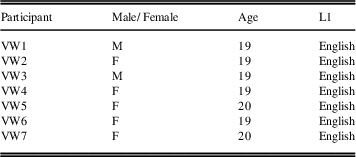
The second group also consisted of seven students, all females aged between 19 and 21 (see Table 2). The mother tongue for five of them was English and for the remaining two participants, German. Their Spanish was at B1 level according to the CEFR. This group completed similar oral interaction activities in pairs during the last 30 minutes of four two-hour long Spanish classes on the same topics used for the VW Group, with the difference that they did not interact with Spanish native speakers as the VW Group did. They will be referred to as the Classroom Group (CR Group).
Table 2 Information on the CR Group participants
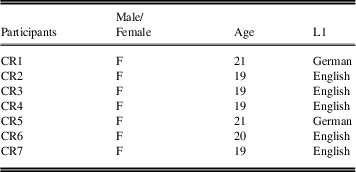
Finally, 68 students of Spanish (levels ranging from A1 to B1) at the same institution participated in the preparatory stage of this study by completing Horwitz et al.’s (Reference Horwitz, Horwitz and Cope1986) FLCAS. This data was used as a reference to compare the FLA scores obtained by the participants in the VW Group and CR Group, as described in section 3.4.
3.2 Learning environment and experimental activities
The VW Group carried out four interaction activities in SL. They received SL training and remote technical checks prior to the start of the study. They were randomly assigned a Spanish native-speaking partner to help them complete the activities. The tandem format was applied: the session time was equally divided between Spanish and English practice. The participants completed one activity every seven to ten days from their respective homes at a time and date agreed with their allocated partners.
The activities proposed for the study took place in “Roehampton Virtual Campus”, a private area in SL owned by the University of Roehampton. A total of fifteen “chatting spots” adapted for each activity were installed in the island (see Figures 1–6).
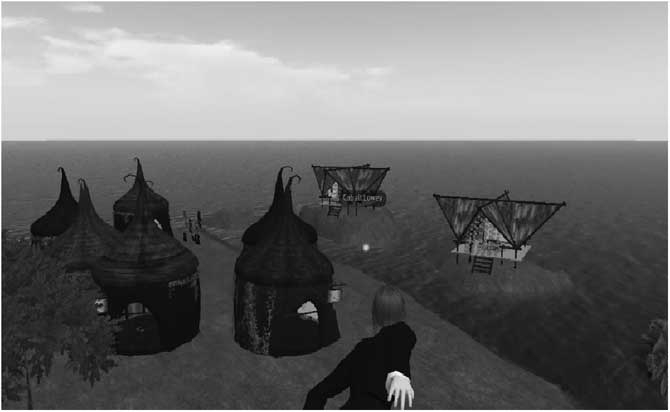
Fig. 1 Bungalow islands
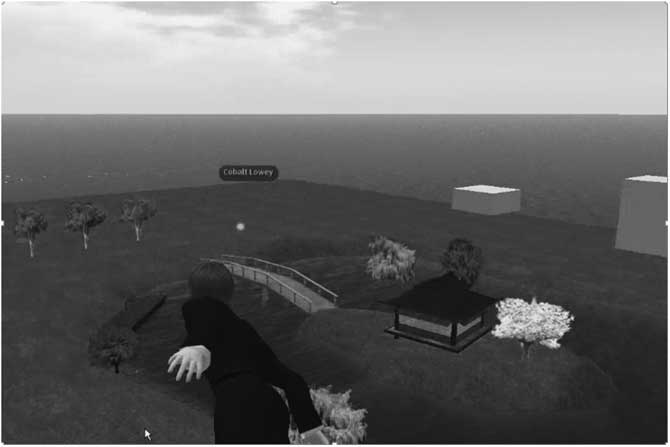
Fig. 2 House by the lake
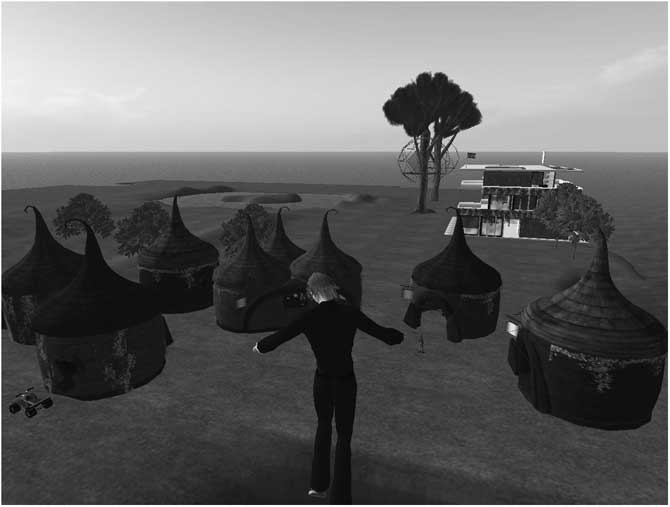
Fig. 3 Hut village
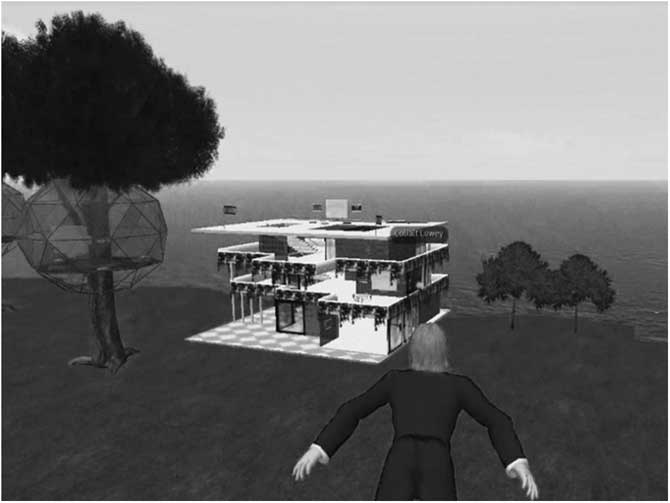
Fig. 4 Tree house and café
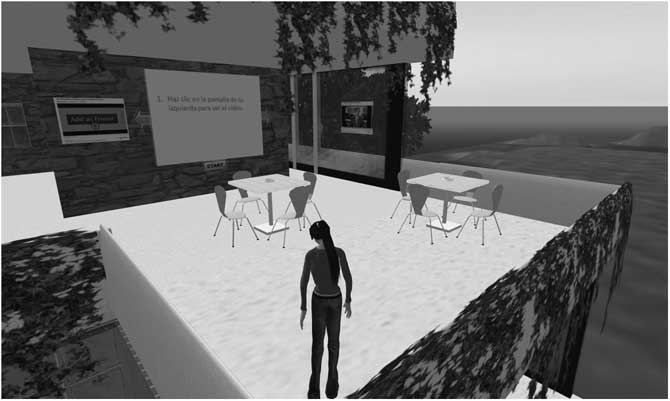
Fig. 5 Café, 1st floor
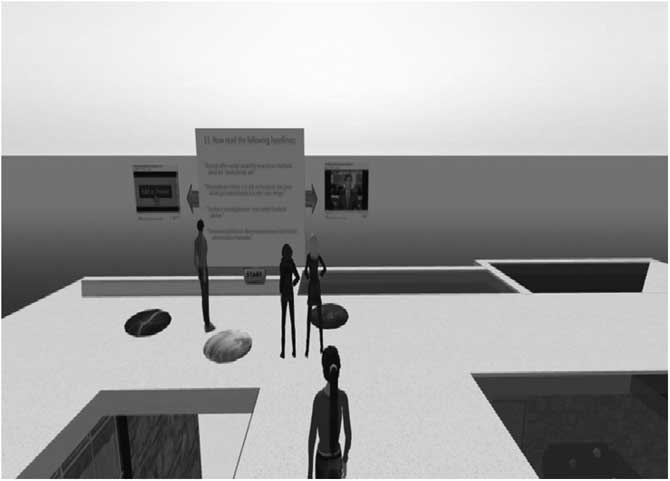
Fig. 6 Café, rooftop
From a technical point of view, the activities were designed keeping requirements and costs to a minimum. The format was simple: in each “chatting spot” students could find screens presenting questions to guide the conversation (see Figures 7 and 8). Two additional screens showed videos related to the topic of discussion.
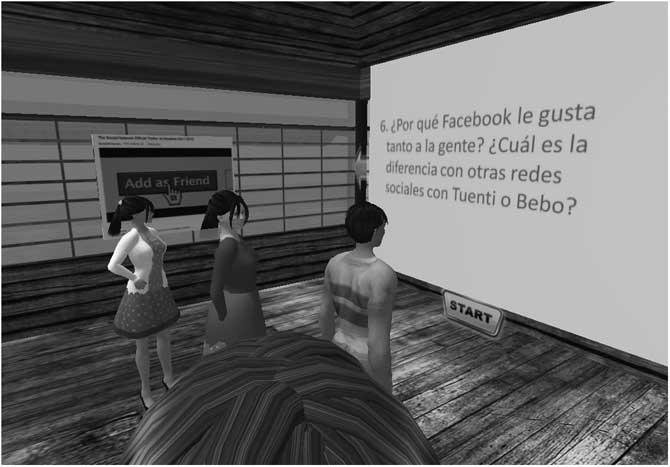
Fig. 7 Chatting spot with a video screen (to the left) and a questions screen (to the right)
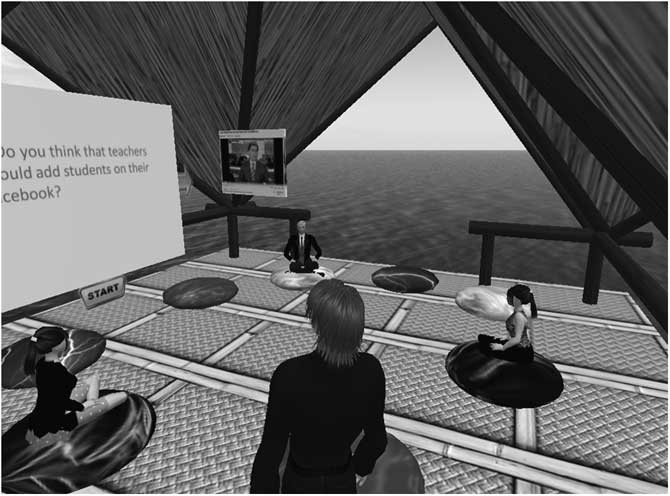
Fig. 8 Screens installed in one of the chatting spots
The activity topics were selected according to two criteria: first, that they would be of interest to the students, and second, that they fitted in the curriculum followed by both institutions.
Activity 1: National Stereotypes
This activity was aimed at discussing clichés about the Spanish and English nationalities and whether they are true or false.
Activity 2: Off to the Cinema
A virtual cinema was created for this activity (Figure 9) in which students watched trailers of films and TV series and compared their preferences.

Fig. 9 Virtual cinema
Activity 3: The Dangers of Social Networks
The students exchanged views about the safety of social networks and about the examples presented in an extract of the Spanish news.
Activity 4: Travelling around SL
The participants took their partners outside “Roehampton Virtual Campus” on a journey across SL areas related to their culture. This activity was designed by the NIFLAR team (Jauregi et al, Reference Jauregi, de Graaff and Canto2011b) and permission was obtained to use it on this occasion. A map showing different SL real locations was distributed to all students (Figure 10).
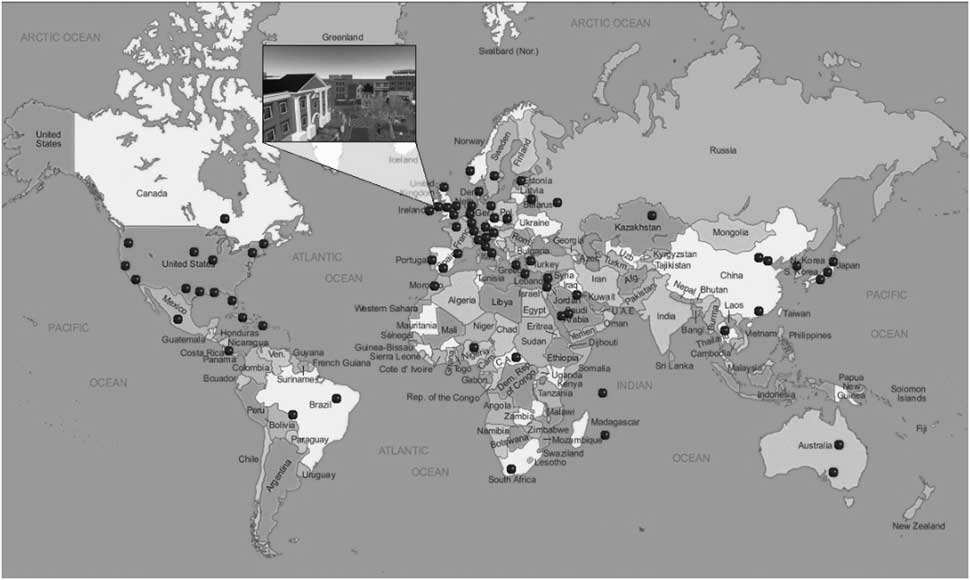
Fig. 10 SL city map (source: New Business Horizons Website, http://www.nbhorizons.com/world.htm)
According to the activity classification proposed by Deutschmann and Panichi (Reference Deutschmann and Panichi2009) specifically for SL, three of the activities designed for this study exploit mainly the social/communicative/cognitive dimension of SL. Activity 4 makes use of the spatial/physical dimension of SL. As discussed by Jauregi, Canto, de Graaff, Koenraad and Moonen (Reference Jauregi, Canto, de Graaff, Koenraad and Moonen2011a: 97), activities in which the VW plays a central role generate less oral interaction. This is why only one of the four sessions was designed in the format illustrated.
Finally, it must be noted that a six-month piloting period took place prior to the main phase of the study, involving technical checks at both institutions and two pilot sessions to test the activities and the data collection instruments. The pilot participants were not involved in the main phase of the study in an attempt to preserve the VW “novelty effect” (Jauregi et al., Reference Jauregi, de Graaff, van den Bergh and Kriz2012: 12).
The CR Group, as previously mentioned, completed similar oral interaction activities in pairs during 30 minutes of their class time for four consecutive weeks. The topics proposed were the same as those chosen for the VW Group, although certain adjustments had to be introduced on account of the very different educational environments that the interactions took place in – traditional classroom vs a virtual world.
In Activity 1, the CR Group was encouraged to discuss stereotypes about Spain and England after viewing two related videos, which the VW Group was also given access to. A worksheet including the same suggested questions was also made available.
In Activity 2, students were asked to exchange information about their favourite films and TV series from a list including the same titles used for the VW Group. They were also required to explain what those films and TV series were about if their partner had not seen them.
In Activity 3, participants were encouraged to list the main dangers that social networks can pose to their users after viewing a news extract that was also made available to the VW Group. A number of suggested questions were also provided in an attempt to guide the conversation if the students ran out of ideas.
Finally, in Activity 4, the students were asked to choose five tourist spots in London that they would recommend to a Spaniard visiting their city and to explain why they would select those over others.
3.3 Instrumentation
A mixed-methods design with quantitative and qualitative data was applied. In addition, following Daly (Reference Daly1991) and McCroskey (Reference McCroskey1984), who argue that self-reported measures are the most valid indicators of anxiety, a combination of questionnaires and open-ended questions were used for this study. Informed consent from all participants was obtained prior to the data collection phase.
3.3.1 Demographics questionnaire
This questionnaire (Annex 1) consisted of sixteen questions on basic background information about the internet, social media and VW usage. It was completed electronically via KwiksurveysFootnote 2 prior to the first session.
3.3.2 FLCAS (Horwitz et al., Reference Horwitz, Horwitz and Cope1986)
Horwitz et al.’s FLCAS contains 33 items that subjects must rate on a 5-point Likert scale from “strongly agree” to “strongly disagree”. Items relate to anxiety or communicative apprehension, test anxiety and fear of negative evaluation. The original version in English was used. This questionnaire was completed on paper by all participants prior to the first session as well as by the group of 68 students.
3.3.3 Reduced FLCAS
Horwitz et al.’s FLCAS (1986) was the instrument selected to measure FLA in both groups after every interaction session. This test was deemed more appropriate for this specific context than other existing questionnaires, which often refer to the FLA experienced in daily life activities that were of no relevance in this instance. A reduced version of the original questionnaire was produced following Arnold, J. (Reference Arnold2007), Charle Poza (Reference Charle Poza2005), Kitano (Reference Kitano2001) and McNeil (Reference McNeil2014), who also used adapted versions of the FLCAS. Items referring to test anxiety and to classroom situations were omitted, as well as two items relating to hypothetical interactions with native speakers, as this was indeed the context in which the participants of the VW Group would be using their FL. Finally, the questionnaire was operationalised by replacing all mentions to “FL” with “Spanish” and, just in the version circulated to the VW Group, mentions of the “the language class” were changed for “the language exchange”. The final questionnaire contained only seven items of the original FLCAS (items 1, 2, 9, 12, 16, 18 and 31) in an attempt to avoid respondent fatigue.
All participants completed this test after every interaction session. Students in the CR Group completed it on paper at the end of every class. Those in the VW Group were instructed to respond to this questionnaire orally in English and to record themselves in an audio file, the intention being to allow for more elaborate answers. They were also asked to provide an oral summary in the target language about the session that they had just completed. This data has not been used for analysis as the aim of the final exercise was to confirm that students had completed the activities. Students in the VW Group were contacted by their tutor right after the session and were asked to send back their recordings immediately.
3.3.4 Open-ended questions
The VW Group answered a brief questionnaire consisting of three open-ended questions (Annex 2) about how they felt during the VW session. The items were selected from the pilot phase questionnaires. Questions were kept open, as recommended by Campbell, McNamara and Gilroy to allow participants to elaborate their answers freely, perhaps in ways that the researcher might not have envisaged (Reference Campbell, McNamara and Gilroy2004: 99). The participants in the VW Group were asked to record their answers after every session following the same procedure described above. The CR Group was not asked to complete this brief questionnaire given the limited teaching time available.
3.4 Coding and analysis
All data was anonymised assigning an alphanumeric sequence to each of the participants. The statements from the FLCAS and reduced FLCAS were coded on a scale of 1–5. In regular statements (e.g. “I never feel quite sure of myself when I am speaking in my Spanish class”), “strongly agree” was given an FLA score of 5, therefore reflecting high FLA, and “strongly disagree” was given a score of 1. Reverse statements (e.g. “I feel confident when I speak in the language class”) were scored in the opposite way. The FLCAS scores were computed following these guidelines and transferred manually to a spreadsheet.
The answers to the open-ended questionnaire were transcribed using the speech recognition software Dragon Naturally Speaking 12® (Nuance Communications, 2012). The final transcript is 3,900 words long and it has not been included as an annex due to space limitations. A qualitative data analysis was performed by identifying different coding categories (Bogdan & Biklen, Reference Bogdan and Biklen2006) such as “confident” or “nervous” and classifying the students’ comments according to whether they were positive, negative or neutral. A statistical analysis including non-parametric tests, Shapiro-Wilk test, Friedman’s ANOVA tests and post-hoc tests was carried out on the quantitative data.
All participants were classified as high, average or low FLA. Their FLCAS scores, obtained prior to the first session, were compared to those of the 68 students also registered at the University of Roehampton. Following Sparks and Ganschow (Reference Sparks and Ganschow2007), scores higher than two thirds standard deviations above the FLA meanFootnote 3 were classified as high FLA; scores between +0.67 and −0.67 (two thirds) standard deviations were classified as average FLA and those scoring more than two thirds standard deviations below the mean were classified as low FLA.
4 Results
Hypothesis 1: FLA levels in the VW Group will have decreased after four oral interaction sessions with native Spanish speakers in SL.
Table 3 shows the FLA scores per participant per session for the VW Group and the students’ FLA profile (high, average or low) according to their FLCAS scores prior to the start of the sessions.
Table 3 FLA levels per participant and per session (VW Group)
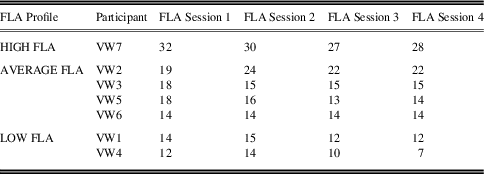
The mean FLA scores per session, shown in Figure 11, were calculated for comparison purposes.
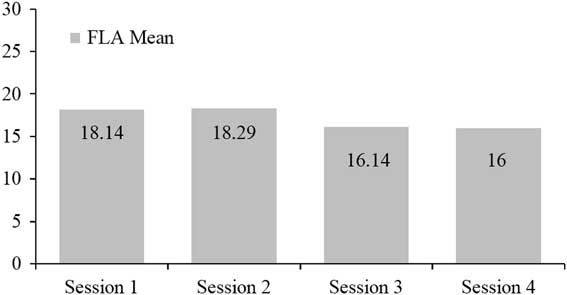
Fig. 11 Mean FLA scores per session (VW Group)
The normality of the distribution of the scores was checked using the Shapiro-Wilk test, suited for small groups (Field, Reference Field2009). Considering the skewness and kurtosis statistics (Skew=1.82; Kurt=3.91) obtained as well as the small number of subjects (N=7), non-parametric tests were used for weekly data comparison as recommended by Field (Reference Field2009).
Selected Friedman’s ANOVA test for dependent data indicated statistically significant differences between sessions [F (3)=9.11; p=0.028]. Post-hoc tests showed statistically significant differences (p=0.038) between the scores registered in Session 2 (N=7; M=18.29; SD=6.24; Mdn=15.00) and Session 3 (N=7; M=16.14; SD=6.09; Mdn=14.00). On the borderline of statistical trend were the differences between Session 1 (N=7; M=18.14; SD=6.64; Mdn=18.00) and Session 3 (p=0.062), Session 1 and Session 4 (p=0.098) and between Session 4 (N=7; M=16.00; SD=6.90; Mdn=14.00) and Session 2 (p=0.062). Results significant at the trend would certainly confirm the hypothesis with a greater research sample.
A question-specific analysis reflects score reductions in questions 1, 2, 4 and 6, which refer to self-confidence, fear of making mistakes and anxiety. Questions 3 and 7, which refer to spontaneous oral expression and fear of negative evaluation respectively, registered a slight increase in scores (see Figure 12).
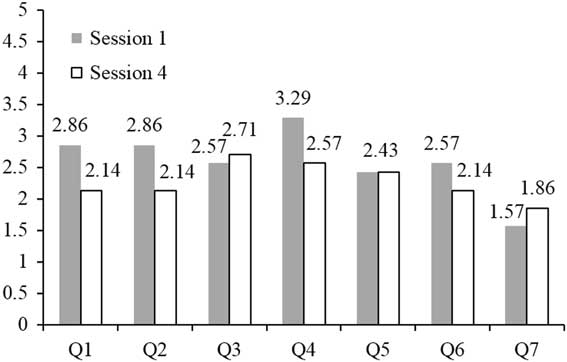
Fig. 12 Mean FLA scores per question in Sessions 1 and 4 (VW Group)
According to the qualitative data gathered, five of the participants report to have felt an increase in self-confidence as weeks went by (VW1, VW2, VW3, VW5, VW7). Here are some of their comments:
“I found that, as I have been doing SL more and more, I’ve kind of started to feel a lot more comfortable with doing it, so I was quite relaxed doing it today.” (VW1, Session 3)
“I’ve noticed I feel a lot more confident with speaking in SL than I have done over the past few weeks, as it gives me the chance to utilise my Spanish skills and build my confidence in terms of speaking Spanish, not just virtually but when I use it in front of, in a face-to-face sort of method, so to speak.” (VW3, Session 3)
“My confidence levels of speaking language have gone up a lot more than I thought they were going to and I feel less silly about making mistakes.” (VW5, Session 4)
Hypothesis 2: FLA levels will be lower in the VW Group than in the CR Group after four oral interaction sessions.
Table 4 shows the FLA scores per participant per session for the CR Group as well as the students’ FLA profile (high, average or low) according to their FLCAS scores prior to the start of the sessions.
Table 4 FLA levels per participant and per session (CR Group)
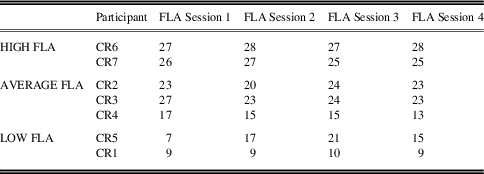
The mean FLA scores per session for the CR Group are shown in Figure 13.
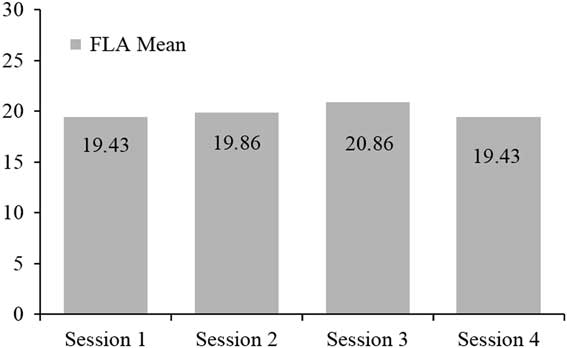
Fig. 13 Mean FLA scores per session (CR Group)
Calculated descriptive characteristics for variables and statistics for skewness and kurtosis indicated that the distribution of the data was not always consistent with the normal distribution. Selected Friedman’s ANOVA test for dependent data indicated lack of statistically significant differences between sessions [F (3)=2.83; p=0.423]. Figure 13 does, however, show a slight FLA increase in Session 3, although the analysis performed indicates that it is not statistically significant. This means that FLA levels for the CR Group remained unchanged over the course of the four sessions.
A question-specific analysis reflects score reductions in questions 2, 4 and 7, which refer to self-confidence and anxiety. Questions 1, 3 and 6, which refer to fear of making mistakes, extreme nervousness and fear of negative evaluation respectively, registered a slight increase in scores. Figure 14 illustrates the differences.
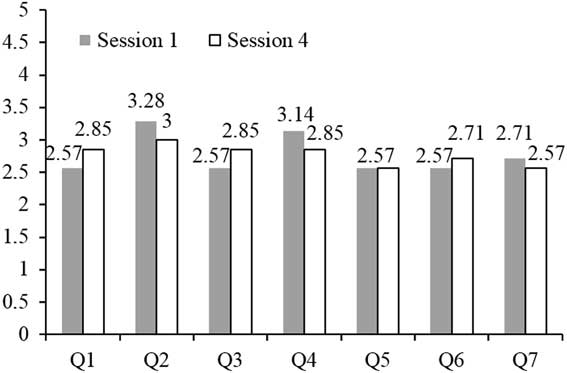
Fig. 14 Mean FLA scores per question in Sessions 1 and 4 (CR Group)
The chart in Figure 15 presents a comparison of FLA levels across weeks between the two groups.
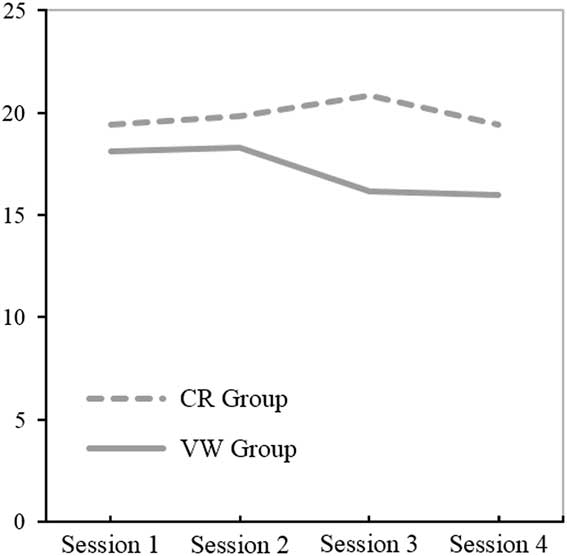
Fig. 15 Mean FLA scores per session for the CR Group and the VW Group
In terms of the qualitative data provided by the VW Group for the analysis of the second hypothesis, five of the participants stated that not being physically present made them feel more at ease (VW1, VW2, VW5, VW6, VW7). They mention the fact that their reactions cannot be seen and that they are in a more relaxed environment as compared to a face-to- face context:
“I think being on the computer makes you a bit less nervous because they can't really see how you're reacting, your facial expressions and things like that, so I think it may be better that you do it on the computer, especially if you don't know the person you're talking to.” (VW2, Session 1)
“I think not being physically present in the language exchange is a bit better because you feel a lot more relaxed compared to if you were face-to-face or over webcam.” (VW6, Session 4)
For one of those five participants, however, the difference was said to be only subtle:
“The fact that I wasn’t physically present made it less likely for me to be nervous and slightly more confident when I was speaking but I don’t think it has that much of an impact.” (VW1, Session 2)
It is interesting to highlight that for three of the participants the anonymity provided by the environment no longer made a difference after a few weeks and they all mention the fact that they felt they knew their interlocutors as the main difference:
“I think it was a little bit easier speaking into a computer than it was being physically present […]. I think it did have an impact on how nervous I was only because I didn’t know him beforehand.” (VW5, Session 1)
“Not being physically present in the language exchange didn't really have any impact on how nervous or confident I was because I've spoken to her before so I didn't really feel nervous this time.” (VW6, Session 2)
The fact that I wasn’t physically present with the person, didn’t really matter to me ’cause I know who she is now and I’ve talked to her a couple of times, so this really didn’t matter to me and it didn’t affect my nerves or confidence. (VW7, Session 3)
One of the participants (VW3) stated that the lack of physical presence did not have any impact at all and finally, in one case (VW4) this anonymity was perceived as something negative, as it prevented the student from putting their personality across. None of the participants claimed to be worried about making mistakes. Here is one of the comments provided:
“I really don’t like SL. It feels a bit like you’re having a cyber-relationship, and it’s a bit strange. It’s OK speaking but then it was kind of difficult as well because there was a delay because of the microphone and it’s kind of awkward talking to somebody you don’t know without even being able to see them. I don’t like it, I like to be face-to-face to people, because I feel like I’m more confident, I’m just more bubbly and I can get my personality across in real life. It’s harder over the internet ’cause you don’t know if they are taking your sense of humour and stuff the right way.” (VW4, Session 1)
5 Discussion
The analysis of the data described reveals that mean FLA levels decreased markedly for the VW Group as weeks went by. This trend was observed in five of the seven participants from all FLA levels (high, average and low FLA). The decline in FLA scores seems to come from answers to questions related to self-confidence, fear of making mistakes and anxiety, which might indicate that VWs are indeed perceived by users as safe environments as suggested in the literature (Cooke-Plagwitz, Reference Cooke-Plagwitz2008; Deutschmann et al., Reference Deutschmann, Panichi and Molka-Danielsen2009; Dickey, Reference Dickey2005). These results are supported by the comments provided by most of the participants in which they report feeling more confident interacting via the VW. This finding would therefore confirm the first research hypothesis. It should be noted, however, that scores obtained in questions related to spontaneous oral expression and fear of negative evaluation experienced a slight increase. Spontaneous oral expression is described by Young (Reference Young1990) as one of the main FLA triggers. It would not be surprising to find increased scores in this item, particularly as students did not prepare for the sessions in advance. Further research into fear of negative evaluation, the second item that recorded an increase in scores, will be required. If participants felt truly “shielded” behind their avatars, they would probably be less likely to experience fear of negative evaluation. This may indicate that the anonymity afforded by VWs only plays a role in an initial contact with an interlocutor who is unknown to us and it would fade as a relationship develops and familiarity between interlocutors increases.
The analysis performed on the data available for the second hypothesis indicates that the FLA levels recorded for the VW Group were lower after four sessions than those in the CR Group, where scores remained unchanged. This finding is in line with Wehner et al. (Reference Wehner, Gump and Downey2011). The VW Group and the CR Group present comparable profiles according to the data gathered via the complete FLCAS circulated before the start of the activities. The VW Group scored a mean of 86.86 points and the CR Group scored 86. A student-by-student analysis shows that both groups present an almost identical spread across FLA profiles (low, average, high), with the majority of them being classified as average FLA. However, in Session 1, FLA levels were slightly higher in the CR Group (19.43) than in the VW Group (18.14). This is surprising, as the VW Group was being faced with a new interaction context, which would justify higher FLA levels, whereas the CR Group was in a regular language class. Further research will be required to shed light on which factors might be responsible for this.
A close analysis of the weekly scores on Session 1 and Session 4 reveals that the participants in the CR Group reported decreased self-confidence and increased anxiety, therefore reflecting a typical scenario of the FLA often experienced in the classroom context. On the other hand, improved scores on fear of making mistakes, fear of negative evaluation and extreme nervousness were recorded. Further work, possibly including student interviews, will be required to fully understand these differences in scores.
The analysis of the qualitative data gathered regarding the potential effect of anonymity showed that five of the participants in the VW Group claimed to feel more confident because they knew they were not being seen by their exchange partners. However, as they completed more sessions, anonymity was no longer responsible for this effect. When asked if the lack of physical presence made them feel more confident or nervous, they answered that it did not have any effect because they already knew their interlocutors. This might suggest once again that being “shielded” behind an avatar provides a valuable sense of security to interlocutors initially, when they do not know each other, but it wears off as familiarity increases.
Finally, the qualitative data gathered also supports Hampel et al.’s (Reference Hampel, Uschi, Hauck and Coleman2005) conclusion that VW interaction may cause a feeling of disembodiment that may be liberating for some users and restricting for others. In the current study, a negative effect of disembodiment was reported by one of the participants (VW4), whose comments also confirm Child’s (2010) notion of resistance to VWs.
6 Conclusions
As discussed in this article, CMC media have been said to be low anxiety environments that may be particularly suitable for language learning. Satar and Özdener (Reference Satar and Özdener2008), Roed (Reference Roed2003) and Arnold, N. (Reference Arnold2007) showed that FLA levels decrease after FL interaction via chat applications. Not many studies have shown this when it comes to VWs, which is what this paper set out to analyse. The results obtained for Hypothesis 1 indicate that FLA levels decrease after four weeks of VW oral interaction. It also confirms that FLA levels are lower in a group of students that interacts orally via a VW than those of a group who interacts in the traditional classroom (Hypothesis 2).
The conclusions obtained from the qualitative data also shed light on the reasons that might influence lower FLA levels in a VW and on the effects of anonymity. Numerous scholars have hypothesised about how users may feel “shielded” behind their avatars, which may help reduce their anxiety levels. Yet, this study shows indications that this effect may only occur at the outset, when users do not know each other, therefore wearing off as familiarity between them increases. At that point, the benefits linked to this feeling of familiarity towards their interlocutor seem to override those of not being seen, of being shielded behind an avatar. Users may feel more at ease simply because they are interacting with someone who seems known to them. VWs thus offer a much-needed gentle beginning that enables learners to build up a gradual familiarity with their interlocutor. This was the experience observed in this particular study, where the tandem approach was used. It would be interesting to ascertain if the same effect occurs when interactions are carried out with non-native speakers of the target language.
This study is not without its limitations. The sample of participants used is small and, although most of the findings yielded are backed by statistically significant data, it is not the case for the question-specific analysis. Further research with larger samples will therefore be required to confirm some of the conclusions obtained in this study.
It would have been desirable to gather qualitative data from the CR Group as well as from the VW Group. However, the limited contact class time available for a university 20-credit module meant that no time could be spared for the students to answer an open-ended questionnaire during class time.
Future research on how specific FLA student profiles (low, average, high) respond to the use of VWs for oral interaction would be desirable.
Appendices
Annex 1 Demographics questionnaire
Please answer the following questions.
-
1. Please enter your initials.
-
2. Please enter your date of birth.
-
3. Please specify if you are male or female.
-
4. How long have you studied Spanish for? Please specify if it was at school or university level.
-
5. How many hours per day do you use your computer/laptop/notebook for leisure?
-
6. Do you use social networks such as Facebook, MSN, Skype?
-
7. How often do you use those sites?
-
8. Do you use Facebook, MSN, Skype to chat with your friends?
-
9. How often?
-
10. Do you use the Blackberry or iPhone Messenger Service?
-
11. Do you use Skype to speak (not chat) with your friends?
-
12. How often?
-
13. Do you play videogames?
-
14. How often?
-
15. Do you use virtual worlds like Second Life, Active Worlds, Home?
-
16. How often?
-
17. Before doing this project, had you ever used Second Life?
All your answers will be kept in strict confidentiality. Thank you!
Annex 2 Open-ended questionnaire
Please answer the following questions at length.
-
1. How did you feel speaking Spanish in Second Life today?
-
2. How did you feel about not being physically present in the language exchange? Did this have any impact on how nervous/confident you felt speaking Spanish?
-
3. How did you feel today about making mistakes?
All your answers will be kept in strict confidentiality. Thank you!
























